
Apiaceae or Umbelliferae is a family of mostly aromatic flowering plants named after the type genus Apium and commonly known as the celery, carrot or parsley family, or simply as umbellifers. It is the 16th-largest family of flowering plants, with more than 3,800 species in about 446 genera, including such well-known and economically important plants as ajwain, angelica, anise, asafoetida, caraway, carrot, celery, chervil, coriander, cumin, dill, fennel, lovage, cow parsley, parsley, parsnip and sea holly, as well as silphium, a plant whose identity is unclear and which may be extinct.

Petroselinum is a genus of two parsley species of flowering plants in the family Apiaceae, native to western and southern Europe and northern Africa.

Oenanthe, known as water dropworts, oenanthes, water parsleys, and water celeries, are a genus of plants in the family Apiaceae. Most of the species grow in damp ground, such as in marshes or in water.

Smyrnium olusatrum, common name alexanders is an edible flowering plant of the family Apiaceae (Umbelliferae), which grows on waste ground and in hedges around the Mediterranean and Atlantic coastal regions of Europe. It was formerly widely grown as a pot herb, but is now appreciated mostly by foragers.
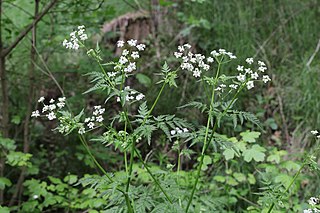
Anthriscus sylvestris, known as cow parsley, wild chervil, wild beaked parsley, Queen Anne's lace or keck, is a herbaceous biennial or short-lived perennial plant in the family Apiaceae (Umbelliferae), genus Anthriscus. It is also sometimes called mother-die, a name that is also applied to the common hawthorn. It is native to Europe, western Asia and northwestern Africa. It is related to other diverse members of Apiaceae, such as parsley, carrot, hemlock and hogweed. It is often confused with Daucus carota, another member of the Apiaceae also known as "Queen Anne's lace" or "wild carrot".
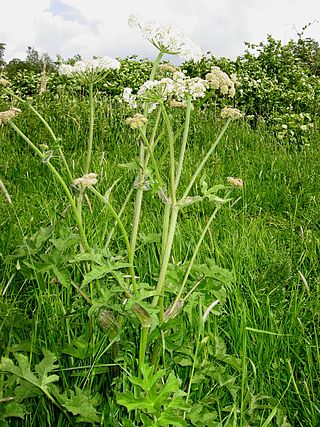
Heracleum sphondylium, commonly known as hogweed, common hogweed or cow parsnip, is a herbaceous perennial or biennial plant, in the umbelliferous family Apiaceae that includes fennel, cow parsley, ground elder and giant hogweed. It is native to Europe and Asia. The common name eltrot may also be applied, but is not specific to this species. Umbelliferous plants are so named because of the umbrella-like arrangement of flowers they produce. The North American species Heracleum maximum is sometimes included as a subspecies of H. sphondylium.

Portencross is a hamlet near Farland Head in North Ayrshire, Scotland. Situated about three kilometres west of Seamill and about two kilometres south of Hunterston B nuclear power station, it is noted for Portencross Castle.
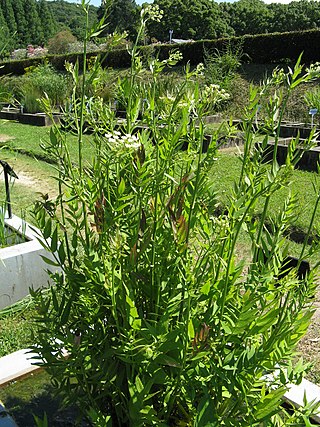
Sium suave, the water parsnip or hemlock waterparsnip, is a perennial wildflower in the family Apiaceae. It is native to many areas of both Asia and North America. The common name water parsnip is due to its similarity to parsnip and its wetland habitat. The alternate common name hemlock waterparsnip is due to its similarity to the highly poisonous spotted water hemlock.

Oenanthe pimpinelloides is a species of flowering plant in the family Apiaceae known by the common name corky-fruited water-dropwort. It is a plant of damp or dry grassland and more ruderal tall herb communities.
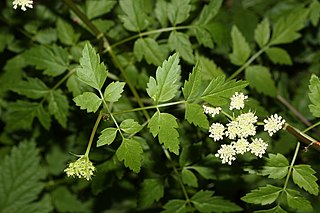
Oenanthe sarmentosa is a species of flowering plant in the family Apiaceae known by the common name water parsley. It is native to western North America from Alaska to California, where it grows in wet areas, such as streambanks. It is sometimes aquatic, growing in the water. The plant has been used in cultivation in wetlands, and the recent discovery of several colonies growing by a stream in Illinois demonstrates its capacity to become a noxious weed if it is introduced elsewhere. This is a perennial herb growing to a maximum height near 1.5 meters. The leaves have blades up to 30 centimeters long borne on petioles up to 35 centimeters in length. The parsley-like leaf blade is divided into serrated, lobed leaflets. The inflorescence is a compound umbel of many flowers with bright white to red-tinged petals.
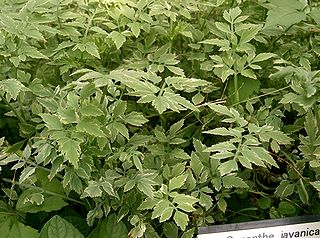
Oenanthe javanica, commonly Java waterdropwort, water celery, water dropwort, Chinese celery, Indian pennywort and Japanese parsley, is a plant of the genus Oenanthe originating from East Asia. It has a widespread native distribution in temperate Asia and tropical Asia, and is also native to Queensland, Australia.

Ligusticum scoticum, known as Scots lovage, or Scottish licorice-root, is a perennial flowering plant in the celery family Apiaceae found near the coasts of northern Europe and north-eastern North America. It grows up to 60 centimetres (24 in) tall and is found in rock crevices and cliff-top grassland. It is closely related to, and possibly conspecific with, Ligusticum hultenii from the coast of the northern Pacific Ocean. The plant is edible and contains the compound sotolon, which is also present in fenugreek. The leaves have a flavour similar to parsley or celery, while the seeds taste similar to fenugreek or cumin.

Oenanthe crocata, hemlock water-dropwort is a flowering plant in the carrot family, native to Europe, North Africa and western Asia. It grows in damp grassland and wet woodland, often along river and stream banks. All parts of the plant are extremely toxic and it has been known to cause human and livestock poisoning.

Oenanthe aquatica, fine-leaved water-dropwort, is an aquatic flowering plant in the carrot family. It is widely distributed from the Atlantic coast of Europe to central Asia.
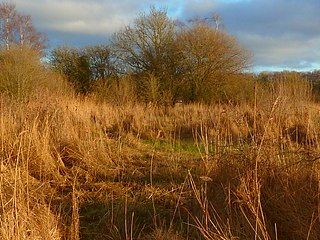
Farnham Mires is a Site of Special Scientific Interest, or SSSI, to the east of the village of Farnham, North Yorkshire, England. It consists of a spring-fed marshy fen or mire with reeds and sedge, and drier calcareous grassland containing a diverse range of flora. It has a history of poaching and fox hunting, but since the late 19th century, the attention of botanists has been drawn to its large variety of flowering plants. It has received some consideration on this account since 1944, and from 1954 it was designated SSSI status. This site has no facilities, and is not open to the public.

Helosciadium × longipedunculatum, synonym Apium × longipedunculatum, is a hybrid plant in the umbellifer family (Apiaceae); the result of hybridisation between Helosciadium repens and Helosciadium nodiflorum.
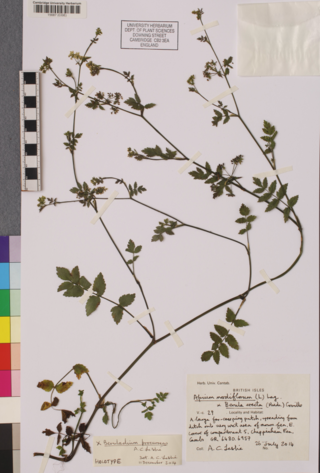
× Beruladium procurrens is an intergeneric hybrid plant in the umbellifer family (Apiaceae); the result of hybridisation between Berula erecta and Helosciadium nodiflorum.

Oenanthe fistulosa, tubular water-dropwort, is a flowering plant in the carrot family, native to Europe, North Africa and western parts of Asia. It is an uncommon plant of wetlands, growing around pools and along ditches, mainly in areas of high conservation value.

Oenanthe fluviatilis, the river water-dropwort, is a flowering plant in the carrot family, Apiaceae, which is endemic to north-west Europe. It grows only in clear, unpolluted rivers and is declining throughout its range.

Oenanthe silaifolia, narrow-leaved water-dropwort, is a flowering plant in the carrot family, which is native to Europe and adjacent parts of Asia and North Africa. It is an uncommon plant of water-meadows and wetlands.


























